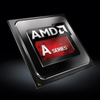The APU - Richland and PileDriver
APU
An APU is a processor series with integrated graphics (in the processor die), an idea much like what Intel did with Sandy Bridge and later on Ivy Bridge processors. APU is an abbreviation for Accelerated Processing Unit. Back in 2005, when AMD bought ATI, rumors immediately popped up about the technology you will learn about today. Earlier last in 2011 you have noticed the introduction of APUs like the E350 (Zacate and Ontario chips), these however can be seen as 'Atom' like processors for netbooks and entry level notebooks. The Llano series was intended to address the entry-level to mid-range segment of both the notebook, but also desktop market. The APU processor reviewed today for example is targeted against Intel's Haswell Core i3 and i5 processors. Now, processor performance wise things will be easy, Intel has the upper hand, but the GPU architecture in Richland is more advanced allowing you to do much more with fewer components in your PC, especially in the multi-media segment. The overall experience as such is much more powerful. Combine that with a much more advanced motherboard chipset and the new A85(X) series motherboards, and you'll notice that AMD has a lot to bring to the table.
So what is Richland?
The previous generation of AMD APUs where labeled Trinity, the 2nd generation APUs. That in fact has not changed. Richland really is Trinity with some modest tweaks on clocks, turbo's, voltages and memory controller. The second to last generation technology was called Llano, which will remain available for quite a while we think. Trinity and Richland are based on the very same 32nm fabrication. For the CPU part this APU comes with what is called piledriver cores, four of them. The Piledriver core on its end is a 2nd generation Bulldozer core which on that end you guys all know from the FX series processors.
For the GPU part of the APU things have changed a bit. Richland now has a faster clocked Radeon GPU with 384 shader cores. The distinct difference is that Llano had an architecture based on the Radeon 5000 while Trinity makes use of Radeon 6000 architecture which you all know under the northern islands codenames. Also an upgraded model video-encoder has been integrated, based on the latest Radeon 7000 series.
- AMD calls the GPU embedded into the A10 5800 the Radeon HD 7660D, it runs at 800 MHz.
- AMD calls the GPU embedded into the A10 6800K the Radeon HD 8670D, it runs at 844 MHz.
- AMD calls the GPU embedded into the A10 6790K the Radeon HD 8670D, it runs at 844 MHz.
- Trinity came with a dual-channel memory controller with official support up-to 1866 MHz, new is low voltage memory support which will make the use of 1.25V and 1.5V very easy.
- Richland comes with a dual-channel memory controller with official support up-to 2133 MHz, with support for low voltage memory support which will make the use of 1.25V and 1.5V very easy.
Richland has a 246 mm² die-size and has 1.3 Billion transistors. To make a bold comparison, Intel has a 216mm² die on 32nm Sandy bridge processors which have 1.16 Billion transistors. Ivy bridge and Haswell (22nm) have 1.4 Billion transistors.
Trinity & Richland APU die
Piledriver CPU Cores
We do need to get a little deeper into the processors cores as there have been significant changes if we look back at Llano. The 2nd generation Bulldozer cores are Piledriver, as such Piledriver cores are used inside the Trinity & Richland APUs. AMD claims that they have tweaked the logical CPU cores a little to make them perform the way they are intended to be. Inside the APU you'll spot two clusters, or modules fir the CPU side of things. Inside the modules we see two integer CPU-cores which both share a floating point unit. Each module has a 2MB L2 cache. Trinity uses two of these modules which brings it towards four logical processor cores. Mind you that there will be Trinity versions out with one module disabled, and thus will be 2-core solutions. That also means that each of the four CPU cores will have 64KB instruction + 64KB data L1 cache per CPU core. Then there's 1MB of L2 cache per CPU core and for Piledriver. There's no shared L3 cache. The processor cores have been tweaked though and the average instruction per clock-cycle has improved by another say 10%. Good news is to see support for ISA instructions including FMA4/3, AVX, AES and XOP. One more improvement for Richland is AMD Turbo Core 3.0, and the technology has been enhanced. The Turbo mode can clock the processor cores up and down real fast when the power usage and temperature allow for it. The A10-6800K APU tested today can turbo towards 4400 MHz.
So Richland has three primary elements merged into the APU; the Northbridge, the CPU and the GPU. Intel places more focus on raw CPU performance, AMD places more focus on the multi-media experience, thus the GPU. There's a heck of a lot more to be found inside the APU though, a DDR3 memory controller, Unified Video Decoder core logic, that Northbridge, a PCI Express interface (24 lanes) and of course a DDI interface to output to digital monitors.



